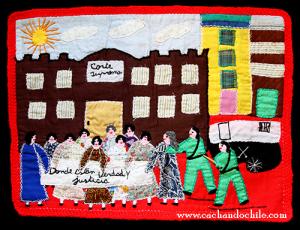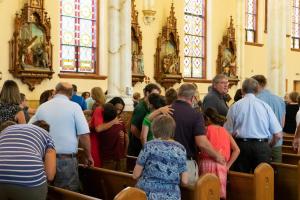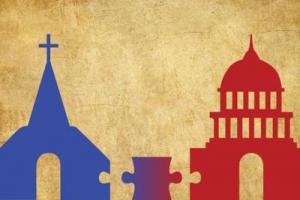Torture and Eucharist, Chapter 3

In the 1970’s under the cruel Pinochet regime, the Church in Chile came to realize that its ecclesiology was inadequate to the circumstances. William T. Cavanaugh, in Chapter Three of Torture and Eucharist, explains the origin and fate of that ecclesiology.
On Chapter Three of Torture and Eucharist: Theology, Politics, and the Body of Christ, sixth in the series on William T. Cavanaugh, a Catholic theologian who writes about the Church and its role in culture, politics, and economics. Introduction to Cavanaugh and links to blogs in the series as they appear are here.
About the second quarter of the 1900’s the Church in Chile changed its ecclesiology, its understanding of itself as Church. That change had been developing in the worldwide Church since the late 1800’s. A Church that had been nearly identical with secular powers separated from politics and limited itself to moral persuasion.
It seemed to be an improvement over what had gone before. Starting with Constantine and developing greatly through the Middle Ages, the Church had become a powerful player in a world that was essentially Christendom. With increasing secularization and independence of secular states, that had to change.
A new theology recognized the state’s autonomy in its sphere but carved out a sphere for the Church’s own autonomy. The two spheres were the material and the spiritual, or external/body and internal/soul. Many hailed this development as a great advance. Cavanaugh sees how it led to an unhappy ending, certainly in Chile of the 1970’s and 80’s.
Catholic Action
Pope Pius XI saw the dangers of collectivism in the communist countries and individualism in the capitalist world. In the Italian context Pius XI was seeking a living arrangement between the Church and Fascist Italy. In a changing political world, the Pope wanted a sphere of autonomy for the Church. His encyclical Quadragesimo Anno tried to solve this problem while offering an alternative to both collectivism and individualism. It imagined a world where many societies of different types mediate between the individual and the state. There would be unions, clubs, sodalities, charitable enterprises.
The Church’s role would be to form individual Catholics for their proper participation in the various groups. This combination of formation by the Church and consequent action in the world went by the name “Catholic Action.” In Pius XI’s words, Catholic Action
neither engages in politics nor brings an undesired rivalry, but solely seeks to make good Christians living their Christianity. (p. 138)
Catholic Action steered between privatization of religion and political entanglement. The participants received spiritual formation for their souls. That formation directed them toward the “real world.” They were to apply their strengthened faith to their work and any problems they met.
The weakness of Catholic Action
Catholic Action inspired many social justice movements, especially in Latin America. I remember the term from the story of Rigoberta Menchu, Guatamalan civil rights activist. She won the Nobel Peace Prize for her work during the 1960’s civil war in that country. I, Rigoberta Menchu tells her dramatic story.
The weakness of Catholic Action was in the dualities it preserved—supernature and nature, spiritual and temporal, clergy and laity.
The Gospel finds its way to [the] world indirectly, through the labors of the individual layperson. (p. 139)
The labor is secular, aiming at temporal goals. The spiritual resides in the intention of the person. The church deals in worldly affairs, but not directly. Cavanaugh is not satisfied with Catholic Action. He describes it as
Catholicism which generated a set of ‘values’ applicable to the realm of social problems which exist ‘out there,’ outside of the church. There is no sense that the church itself [is] a body in any way analogous to other social bodies. (p. 141)
Catholic Action in Chile
Catholic Action had a direct influence on the development of liberation theology in Latin America. It provided “a space for the church’s social action while the church was in the process of officially disaffiliating itself from political party alliances.” (p. 142)
The National Association of Catholic Students was “the most important building block of Catholic Action in Chile.” (p. 142-43) Progressive leaders of the future Christian Democratic Party grew up in this group. Also receiving early formation there was a university professor named Jaime Eyzaguirre. He taught some of the Pinochet regime’s “main ideologues.” (p. 143) That must mean there was something ambiguous about Catholic Action.
Nevertheless, inspired by encyclicals Rerum Novarum and Quadragesimo Anno, members of Catholic Action pursued progressive policies in Chile. Conservative bishops worried about that but eventually promoted Catholic Action anyway. Communist and Fascist elements had been growing in Chile in the 1930’s. Catholic Action would “steal the Marxists’ clothes by offering an alternative vision of improved conditions for the worker.” (p. 144)
Anti-Communism fostered a sense of patriotism and a desire to produce good citizens for the Patria.
[P]atriotic military rhetoric in Catholic Action was common, and served to make the unity of the nation-state its natural field of discourse. (p. 145)
That unity, however, was a fiction that only the elite entertained. “While Catholic Action went to the poor, it was not successful in coming from the poor.” (p. 146) It was the Marxists who were able to organize the youth, workers, and campesinos.
The interiorization of the Church
Gradually adapting to circumstances, the Church began to pay attention to different environments (ambientes) in society, including poor sectors. The Church defined an ambiente as people
gathered by the same way of living, of thinking, of acting, of cultivating themselves, of conceiving of science, art, politics, of amusement; that have the same reactions, the same sympathies or antipathies, together with the psychological bonds which unite them in the same conduct of life. (p. 148)
Unfortunately, the Church could not see itself as an ambiente. An ambiente is a visible social body. The Church saw itself as a mystical body. It was “a repository of the spirit of Christ which is sent forth to penetrate the various ambientes.” The crucial image is “sent forth,” that is out to what is not the Church.
St. Paul, who gave us the term “body of Christ,” saw that body as a visible unity, harmonizing all the different ways of being human. The Church in Chile intended to be only the invisible interior of the various factions. It would form the consciences of individual Christians. They would bring that Christian attitude to their various places in society. But it was the state that would be the visible unity. “Any attempt to enact the Body of Christ was defined as a confusion of the spiritual and temporal.” (p. 149)
The Mystical Body of Christ
I remember the “Mystical Body of Christ” as one of my favorite images for the Church. Pius XII had promoted this image in an encyclical in 1943. I remember feeling disappointed when Vatican II demoted “Mystical Body” in favor of “the People of God.” It seemed too ordinary, not very exciting.
Pius XII’s idea was a needed correction to the heavy involvement of the Church in temporal affairs that had characterized the age known as Christendom. The “New Christendom” was to be “a happy relationship between two spheres, the sacred and the secular. The Church would operate in the interior sphere of the sacred. The state’s competence would be the exterior or material world. The Church as a body would not interfere in the state’s field. After all, the Church’s body was “mystical.”
On the other hand, Christians formed in conscience by the Church would bring their values to the places where they lived, including the political realm. They would apply their religious formation in the secular realm using secular means and reasoning. It was to be a happy relationship between the two more or less separate spheres.
The story in Chile did not have such a happy outcome.
Image credit: Sacred Heart Parish via Google Images












